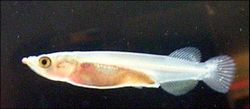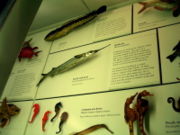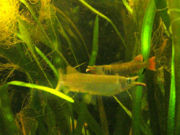Halfbeak
2007 Schools Wikipedia Selection. Related subjects: Insects, Reptiles and Fish
| iHemiramphidae | ||||||||||
|---|---|---|---|---|---|---|---|---|---|---|
A marine halfbeak, the ballyhoo, Hemiramphus brasiliensis
|
||||||||||
| Scientific classification | ||||||||||
|
||||||||||
|
|
||||||||||
|
Arrhamphus |
Halfbeaks (family Hemiramphidae) are an important family of epipelagic fish inhabiting warm waters around the world. The family is divided into two subfamilies, the Hemiramphinae and the Zenarchopterinae, each containing about half the known species. In a recent review of the family, two subfamilies, 14 genera, and 117 species and subspecies were recognised. Halfbeaks are named after their elongate jaws, the lower of which is usually significantly longer than the upper one, and it is this feature provides the family with its common name; the family name, Hemiramphidae, comes from the Greek hemi, meaning half, and rhamphos, meaning a beak or bill.
The Hemiramphinae are primarily marine and found in the Atlantic, Pacific, and Indian Oceans, though some inhabit estuaries and rivers. The Zenarchopterinae are confined to the Indo-West Pacific zoogeographic region, an area running from East Africa to the Caroline Islands. The Zenarchopterinae are remarkable for exhibiting strong sexual dimorphism, practicing internal fertilisation, and in some cases being ovoviviparous or viviparous. Three genera in this subfamily are exclusively freshwater fish and several, such as the wrestling halfbeak, have become important aquarium fish.
Marine halfbeaks are omnivores feeding on algae; marine plants such as seagrasses; plankton; invertebrates such as pteropods and crustaceans; and smaller fishes ; as such they form an important link between trophic levels and are eaten by many ecologically and commercially important predatory fish, such as billfish, mackerel, and sharks. They are not commonly fished for commercially, but many artisanal fisheries target halfbeaks, and their meat is considered to be of good quality. In some localities large bait fisheries exist to supply sport fishermen. Freshwater halfbeaks are believed to feed primarily on insects, particularly mosquitoes and spiders.
Phylogeny
Halfbeaks are members of the Beloniformes and close relatives of the flyingfishes, needlefishes, and sauries. However, the precise relationships between these groups has been debated among systematists. Juvenile needlefish pass through a developmental stage where the lower jaw is longer than the upper jaw, sometimes known as the "halfbeak stage", so it has been hypothesised that halfbeaks are paedomorphic needlefish, that is, halfbeaks as adults retain characteristics of the juvenile stages of their ancestors, the needlefish. The alternate view is that the unequal lengths of the upper and lower jaws seen in halfbeaks is the basal condition, with needlefish being relatively derived in comparison.
Morphology
The halfbeaks are long, streamlined fish adapted to living in open water. Halfbeaks range in size from 4 cm (e.g., Nomorhamphus brembachi) to over 40 cm (e.g., Hemiramphus saltator) and all have an elongate, highly streamlined shape. The scales are relatively large and cycloid, that is, smooth. A peculiarity shared by all halfbeaks that distinguishes them from the other fishes in the Beloniformes is that the third pair of upper pharyngeal bones are anklylosed (fused) into a plate. There are no spines in the fins. Most species have an extended lower jaw, at least as juveniles, though this feature may be lost as the fish mature, as with Chriodorus, for example.
Males of the livebearing species have anal fins modified into an andropodium that is used to direct sperm into the female.
As is typical for surface dwelling, open water fish, most species are silvery, and darker above and lighter below, an example of countershading. Small patches of colour, particularly among males, are only found on the fins and the tip of the beak.
Distribution and ecology
Halfbeaks are primarily found in warm seas, predominantly at the surface. A small number are found in estuaries and some species, including all the species in the genera Dermogenys, Hemirhamphodon, and Nomorhamphus, are confined to fresh water. Marine halfbeaks are known from the warm temperate and tropical parts of the Atlantic, Indian and Pacific Oceans, but most of the freshwater species come from Southeast Asia.
The marine species feed on small fish, plankton, algae, and fragments of vegetation such as sea grasses. For some subtropical species at least, juveniles are more predatory than adults. Some tropical species have been observed to feed on animals during the day and plants at night, while other species alternate between carnivory in the summer and herbivory in the winter.
The freshwater species are more exclusively predatory than the marine species, and typically orient themselves into the water current and take aquatic insect larvae, such as midge larvae, and small insects, such as flies that have fallen on the surface of the water.
Importance
The larger species are widely used as food fish and the meat is excellent. Halfbeaks are an important link in the food chain between plankton and large, commercially important predatory fish, and are also important as baitfish for game species including dolphinfish and billfish. Some of the smaller freshwater species are also kept as aquarium fish.
Reproduction
Halfbeaks exhibit a variety of reproductive strategies including egg-laying, ovoviparity, and viviparity. Marine halfbeaks are usually egg-layers and often produce relatively small numbers of fairly large eggs for fish of their size, typically in shallow coastal waters, such as the seagrass meadows of Florida Bay. Juvenile marine halfbeaks are often very common in brackish water habitats such as mangroves and estuaries, only moving offshore once they reach a certain size.
The freshwater halfbeaks of the general Dermogenys, Hemirhamphodon, and Nomorhamphus are all livebearers, that is, they do not lay eegs but instead produce well-developed free-swimming young. However, there is a great deal of variation in the details. Meisner and Burns identified no fewer than five distinct moders of viviparity in the freshwater halfbeaks:
- Type 1: Fertilised eggs retained within the ovarian follicle. Superfetation, that is storage of sperm, does not occur. The eggs are provided with a large yolk sac and have little or no connection to the maternal blood supply. Example: Southeast Asian populations of Dermogenys pusilla.
- Type 2: Fertilised eggs retained within the ovarian follicle. Superfetation does occur, with up to three broods resulting from a single mating. The eggs are provided with a small yolk sac but the embryos instead have a connection to the maternal supply through the coelomic cavity and pericardial sac. Examples: Dermogenys pusilla from Sabah and Dermogenys orientalis.
- Type 3: Fertilised eggs retained within the ovarian follicle only for the early stages of development, with the embryos later developing along the full length of the ovary. Superfetation does occur, and up to two broods can develop simultaneously in the ovary. The eggs are provided with a small yolk sac but the embryos have a connection to the maternal supply through an expanded belly sac. Example: Dermogenys viviparus.
- Type 4: Fertilised eggs retained within the ovarian follicle only for the early stages of development, with the embryos later developing along the full length of the ovary. Superfetation does not occur. The eggs are provided with a large yolk sac and the embryos have no connection to the maternal blood supply. Examples: Nomorhamphus megarrhamphus, Nomorhamphus weberi, and Nomorhamphus towoetii.
- Type 5: Fertilised eggs retained within the ovarian follicle only for the early stages of development, with the embryos later developing along the full length of the ovary. Superfetation does occur, and embryos of different ages can be found in the ovaries. The eggs are provided with a small yolk sac and the embryos only have a connection to the maternal blood supply for only part of their development. Late-stage embryos apparently eat eggs and small embryos in ovary. Note that embryos eating eggs and other embryos has been observed in a few other fishes, most notably sharks (see article on oophagy). Example: Nomorhamphus ebrardtii.
As with other livebearing fish, freshwater halfbeaks produce small broods of large offspring compared with egg-laying species of similar size, with broods of around ten to twenty, 10-15 mm long offspring being typical. Males of the ovovivaparous and vivaparous species all have a modified anal fin, the andropodium, similar to the gonopodium of poecilid livebearers, used to deliver sperm to the females. Although most of the egg laying species mate by shedding the milt externally, as is typical for bony fish, at least some egg-laying species practise internal fertilisation: male Zenarchopterus use a modified anal fin to direct sperm into the genital opening of the female prior to spawning . Halfbeaks therefore show the full range of reproductive methods know to occur in fishes: external fertilisation with egg laying; internal fertilisation with egg laying; internal fertilisation with ovoviviparity; and internal fertilisation with viviparity.
Besides modifications to the anal fin, sexual dimorphism is quite strong in some species, especially among the livebearing freshwater halfbeaks. Female Normorhamphus are much larger than males but aren't as brightly coloured and have shorter beaks. By contrast, male Hemirhamphodon are larger than the females, and some species, such as Hemirhamphodon pogonognathus, also have a long beard-like tassle on the end of the beak.
Halfbeaks in aquaria
Species of the genera Dermogenys and Nomorhamphus are quite commonly kept as aquarium fish; species of Hemirhamphodon and Zenarchopterus are rather less commonly seen. They are small and generally peaceful towards other species, although males can be aggressive to one another. Male Dermogenys pusillius in particular fight vigorously and sometimes these battles end in injuries; this fish has therefore become known as the wrestling halfbeak and in some Asian countries fights between males are used for betting purposes in much the same way as the Siamese fighting fish.
To be kept successfully, halfbeaks require an aquarium with plenty of space at the surface. Depth is not critical, so a tank that is wide is better than one that is deep. They are sensitive to low oxygen levels but are otherwise relatively hardy, with one important exception: they do not tolerate sudden changes in salinity, pH, hardness, or temperature well. They must be introduced to a new aquarium gently, and subsequent water changes are best small but frequent so that the water chemistry does not suddenly change. Some species, most notably Dermogenys pusillius, are said to do best in slightly brackish water, but most species need moderately hard to soft, neutral to slightly acidic, water.
Halfbeaks are nervous fish and things like switching on lights can cause them to swim around the tank frantically. They may hit themselves on the glass, injuring their beaks, or jump out of the tank completely. Injuries to the beak usually heal within a few weeks. They will eat insect larvae such as bloodworms readily, as well as crustacean eggs, shrimps, fruit flies, and even small pieces of chopped white fish. Halfbeaks sometimes eat flake foods as well. Some aquarists also offer them tiny pieces of algae wafer on the basis that most species are omnivorous in the wild, and so a certain amount of green food probably does them good.
Halfbeaks will breed in captivity, but despite being livebearers they are not particularly easy to breed. Miscarriages are common, particularly if the females are stressed or shocked (for example, by being moved to another aquarium). Once the fry have been born, things get much simpler, as the baby halfbeaks are quite big and will eat newly hatched brine shrimps, small live foods such as daphnia, and powdered flake.
Images of halfbeaks









